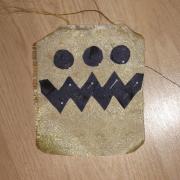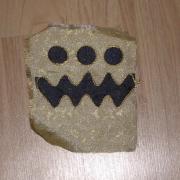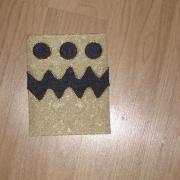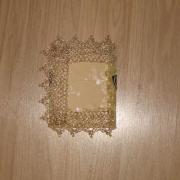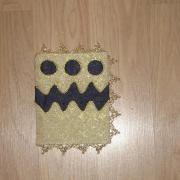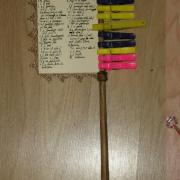You are here
A Venetian Flag Fan
Okay, so it was a bit of a belated birthday present - mostly because I got stuck for a while on how to make up the flag part of the fan. I looked at a number of images of fans, and read an article by La Signora Onorata Katerina de Brescia. This all contributed to the development of my ideas about flag fans.
The h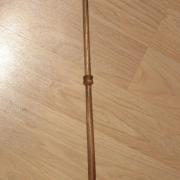 andle itself was easy: I commissioned it from a wood turner. There was no way I would ever have been able to make this myself. Admittedly, a number of fan handles are very simple - but this was a special gift, so I wanted something a bit fancier. I looked at some of the fancier ones, and worked out what elements I liked, and what sort of size I thought the handle should be. I asked for it to be made in walnut if possible, as walnut was the luxury wood of choice for 16th century Italians. Of course, the really fancy ones (like this extant fan) had handles made of ivory - but these days that's just not a good choice.
andle itself was easy: I commissioned it from a wood turner. There was no way I would ever have been able to make this myself. Admittedly, a number of fan handles are very simple - but this was a special gift, so I wanted something a bit fancier. I looked at some of the fancier ones, and worked out what elements I liked, and what sort of size I thought the handle should be. I asked for it to be made in walnut if possible, as walnut was the luxury wood of choice for 16th century Italians. Of course, the really fancy ones (like this extant fan) had handles made of ivory - but these days that's just not a good choice.
I was really pleased with the handle that I had made, it was absolutely beautifully turned and the walnut has a really gorgeous lustre to it.
My back up option was pine, as this was their equivalent of a cheap throwaway wood. I think that, since a number of fan flag panels were made with cheap printed games and puzzles (you can see one on Katerina de Brescia's page), a large number of fans were probably made as cheap gimmicks (maybe souvenirs for festivals?) that could be used and thrown away. Something for me to research further one of these days when I have some free time.... There's also a nice example here of another fan that looks like it may have a printed image on it. I thought the cardboard option would be good for the flag on Lady Anna's fan as on the back side of the flag I wanted to personalise it by adding some shorthand dance notes, in place of having a cheaply printed puzzle.
However, I wanted to use Lady Anna's device on the front side of the fan. I have not yet seen evidence that this was a period practice, but it seemed like a nice personal touch and handy identifier of who the fan belongs to. I started out by painting it onto cardboard, but I wasn't happy with the way that looked - so I maturely sulked at it for a few months.
The other extant fans that I've seen (on Katerina de Brescia's page and the other link above) I thought were made of needlework that has either been done onto something that is fairly heavy weight or has been basted or glued onto something afterwards. Perhaps they are backed with board, or just really well starched? I contemplated embroidering Anna's device, I contemplated outsourcing it to someone else to embroider, and I sulked some more. I've since seen better images of these extant fans here, and I was interested to discover that one is woven from straw, one is punched parchment (I may have to make one of these at some point), and the third is linen with the pattern woven in.
Then I was looking at some images again, and I realised that the patterns on some of the fans looked very much like fabric patterns. I first spotted it in this image of Venus, and also again here. They also tended to attach lace to their fans, such as here and here, so actually making the flag itself out of fabric seemed plausible. I'm not sure how they would have made the fabric stiff so that it behaved in a fan-like manner rather than flopping around in a fabric-like manner, but it seemed to me that the options would be to a) starch it heavily, b) back it with board, or c) wrap it around a small wooden frame of some sort.
Fortunately I had some nice gold fabric and some blue silk, so I was able to use the gold as the background and appliqué on the blue to make up Lady Anna's device. I did the appliqué in a period fashion, tacking the blue silk bits on with running stitch, and then couching gold cord over the top. To stop the cord from fraying at the ends though I dipped it in clear nailpolish. Given my limited materials, skill, and patience, I decided to go with backing the fabric with board, and used my handy craft glue (I could have used fish or cheese glue, but what I had on hand was craft glue) to stick it on with.
A number of images of fans (such as the ones of Venus above) show little tassles on the corners, but I decided I wanted to use lace. I had some fake gold lace that was way too wide, but when glued in place so that only the points showed, it looked quite a lot like the ones you see in some of the links above.
 To hide the raw edges of the fabric and the rest of the lace, I glued another layer of board on - and then pegged it all the way around while it dried to make sure it stuck properly.
To hide the raw edges of the fabric and the rest of the lace, I glued another layer of board on - and then pegged it all the way around while it dried to make sure it stuck properly.
I wrote up the dance in my first attempt at an common Italic script from a period handwriting book. I am not very good at writing neatly so it is a bit blotchy and uneven even though I drew the lines all straight, and the letters aren't quite the same as the sample script. It is a shorthand version of Anna's reconstruction of Cesarina, except I called it Cesarina Non Smorfie as an inside joke. I then glued this on over the backing layer of board.
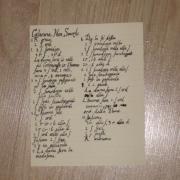 To finish the assembly, I glued it onto the handle. I'm not sure how well it will hold, and I may look at binding it on with thread as well if it needs it in the future, but at the moment it seems to be fairly well attached. I pegged it all the way along while it was drying to really encourage it to stay. What you can't see clearly on images of fans, or on the extant fans, is how the fan was attached to the handle. I suspect that there was a slot or groove and they were glued in place as you would with the feathers to a fan handle for that type of fan. The glue seems to be working for me; another option I've seen on a nice straw fan reconstruction is using tacks to attach it, but my concern would be the possibility of splitting the wood.
To finish the assembly, I glued it onto the handle. I'm not sure how well it will hold, and I may look at binding it on with thread as well if it needs it in the future, but at the moment it seems to be fairly well attached. I pegged it all the way along while it was drying to really encourage it to stay. What you can't see clearly on images of fans, or on the extant fans, is how the fan was attached to the handle. I suspect that there was a slot or groove and they were glued in place as you would with the feathers to a fan handle for that type of fan. The glue seems to be working for me; another option I've seen on a nice straw fan reconstruction is using tacks to attach it, but my concern would be the possibility of splitting the wood.
I'm rea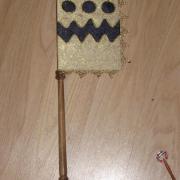 lly happy with the finished product, I think it came up really nicely and I hope Anna is as pleased with it as I am. I have a few different ideas that I would like to try out, which I will have a go at when I get around to making myself a fan as well.
lly happy with the finished product, I think it came up really nicely and I hope Anna is as pleased with it as I am. I have a few different ideas that I would like to try out, which I will have a go at when I get around to making myself a fan as well.
- Log in to post comments
